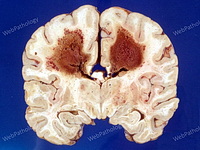Apr 2016
CNS Lymphomas
Reviewer(s): Dharam M. Ramnani, MD
DEFINITION: Primary central nervous system lymphoma (PCNSL) is defined as lymphoma arising in the brain, spinal cord, or leptomeninges without prior or concurrent tumor outside the central nervous system (CNS). CLINICAL: The patients with PCNSL may be immunocompetent or have immunocompromised status. Immunocompetent patients are older with a slight male predominance. PCNSL makes up 1.5% to 3% of primary brain malignancies and about 1% of non-Hodgkin lymphomas in this group. Immunocompromised patients include HIV/AIDS (most common), transplant recipients, and congenital immunodeficiency disorders. The patients are younger with a striking male predominance. The presentation depends upon the site of the tumor and includes motor disturbances, seizures, signs of increased intracranial pressure, and personality changes. MORPHOLOGY:The lesions are usually supratentorial. Involvement of cerebellum and spinal cord is rare. The lesions are solitary or multiple and poorly circumscribed with hemorrhage and necrosis. There may be diffuse meningeal involvement or diffuse subependymal periventricular spread. There is diffuse proliferation of large atypical lymphoid cells with perivascular growth pattern. The vast majority of the cases, especially in immunocompromised patients, are diffuse large B-cell lymphomas (DLBCL) composed of centroblasts, immunoblasts. IMMUNOPHENOTYPE & GENETICS : PCNSL are usually diffuse large B-cell type and express pan B-cell markers such as CD20, CD22, CD79a, and PAX5, and monotypic immunoglobulin (usually IgM). HIV-associated PCNSL commonly express BCL2, LMP-1, EBV nuclear antigen, and EBV-coded small RNA (EBER) by in-situ hybridization. Immunoglobulin genes are clonally rearranged. References: Jaffe, ES et al. (2011), Hematopathology, Saunders/Elsevier, Philadelphia, PA.
























